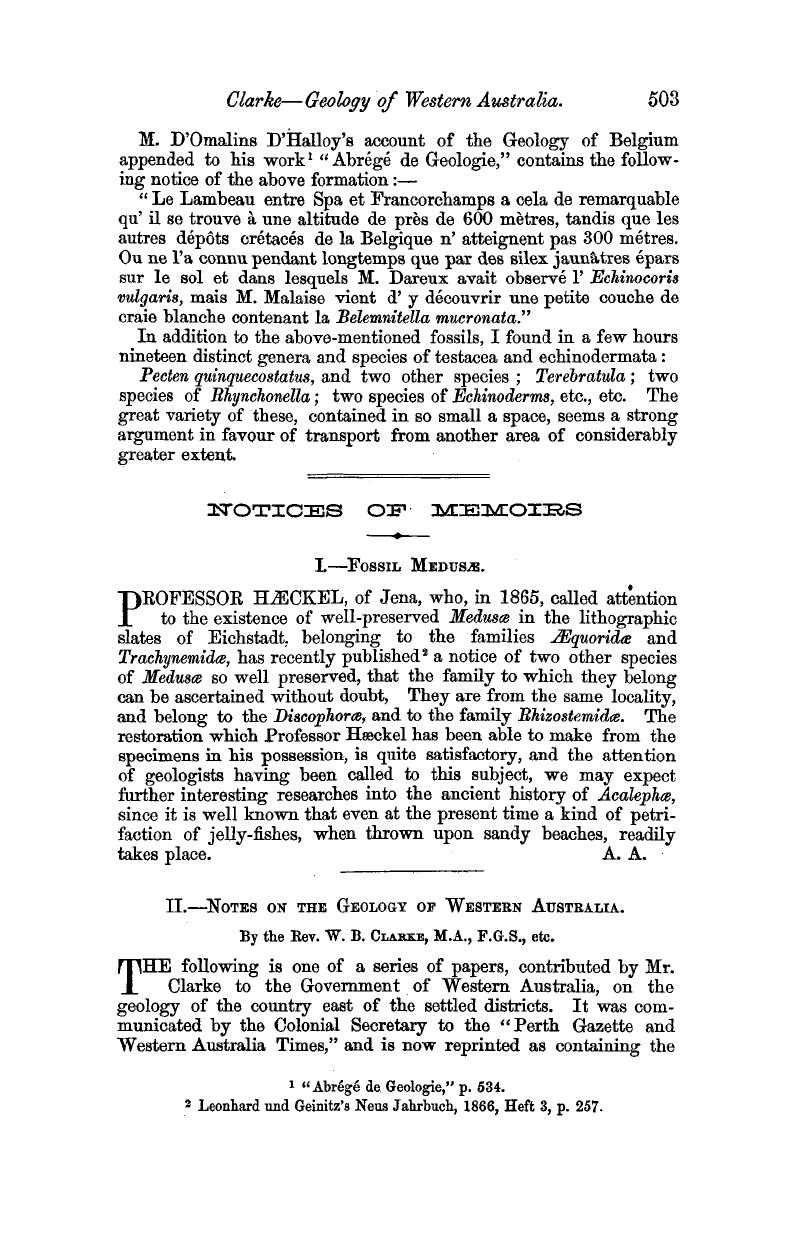No CrossRef data available.
Article contents
Notices of Memoirs
Published online by Cambridge University Press: 01 May 2009
Abstract

- Type
- Notices of Memoirs
- Information
- Copyright
- Copyright © Cambridge University Press 1866
References
page 503 note 2 Leonhard und Geinitz's Neus Jahrbuch, 1866, Heft 3, p. 257.Google Scholar
page 504 note 1 From the “Perth Gazette and Western Australia Times,” Friday, 04 20,1866.Google Scholar
page 504 note 2 This word “deposit” explains the sedimentary nature of the substances which are properly “silicates of alumina.”
page 506 note 1 The dome-like or boss-like form of granite is a feature of frequent occurrence. It is of concretionary origin, and distinguishes especially those hornblendic granites which are connected with auriferous deposits. But it occurs also in other granitic regions, as in the mountains of Central Asia. Where the great bosses meet there is generally a depression, which if repeated in a given direction, may give the idea of a fissure; this may also be the case where joints traverse the rock. Mr. Lefroy mentions intumeseencts of granite, a term well describing the nodular or concretionary structure. He also mentions that near the head of drainage to the westward, there is a dip of about 2 feet in the mile to the south-west. Eyre also mentions that nearer the coast the granite has a slope to the south-westward. A slope of 2 feet in a mile could scarcely occur except on the summit of a nearly level mass. That the granite in the region under discussion must have, occasionally at least, a true nodular structure, may be seen on the nearest part of the coast to Mr. Hunt's furthest, viz: about Esperanee Bay, where the granite exfoliates in decomposition, peeling off in concentric layers like those of concretionary trap. Mr. Lefroy mentions similar features in 32·0 S. and 118° 19' E. at Burra Kukkin. This particular species of granite is about Esperanee Bay full.of garnets, and garnetiferous granite is well known to be not of the most ancient class, and, besides the inferences from this fact, that the rocks must have considerable slopes is to be inferred from the fact that the cliffs of the Australian Bight have, in some places, a vertical thickness of 600 feet, resting on the edges of the granitic base, which begins to crop out on the west side of the great arc of the coast at about 124° E., and on the east side near Fowler's Bay about 132° E., giving to the hollow between the granitic intumescences a breadth of 500 miles. We may, therefore, safely assume that such a hollow is formed by the slopes of the great dome-like masses composing the granite base. That towards the ocean this concretionary or nodular structure may furnish slopes of enormous extent, may be gleaned from a fact stated to me by my friend the late Captain Owen Stanley, E.N., F.R.S., who in H. M. S. Rattlesnake obtained soundings when fairly inside the horns of the Bight, at a depth of four miles. That this is far from surprising may be considered by reference to the data given for the mass of strata supposed to be denuded, in the preceding remarks. For with a slope of the granite or other rock not greater than one degree in the mile, a depth of more than four miles would be reached along the versed sine of the Bight at a distance from the. cliffs of 234 miles, which is within the chord along the 35th parallel. Deep as is this depression of the sea bottom, it is quite evident that the Tertiary and underlying deposits may obtain their present position without any extraordinary concurrence of circumstances. The great width of the Bay and the depth indicated for the ocean off the cliffs of Bundah, justify the probable opening of the Strait alluded to above. Nor can it be without interest to recollect that Flinders, on his survey of the Bight, stated his belief that the sea would be found behind them (vol. i. p. 97). He distinctly refers to a gradual subsiding of the sea, or sudden convulsion of nature, which, however, can have no bearing on the real facts of the case, and to the cylindrical sandy concretions of Bald Head, which have another and truer explanation than he supposed, and yet which, if interpreted in his way, would prove elevation of the coast, which is so far correct. At from 8 to 15 miles from the shore at the, head of the Bight, the depth according to D'Entrecasteux and Flinders is from 27 to 30 fathoms English; the depression, therefore, observed by Stanley is much further out, and beyond the base of the Tertiary platform which extends from the head of the Bight on the south-west side to a parallel with the chord of the Bight about 146 miles south. There is room and depth enough to allow for other formations as well as the Tertiary, which, for want of researches, cannot, however, be proved.—W. B. C.


